Overcoming Normative Educational Crises: The Human Agency Factor
Abstract
Background. The problem of students’ adaptation to a new educational level (normative educational crises, according to Slobodchikov, 2008) is considered. Unlike the literature (Barber & Olsen, 2004; Akçinar, 2013; Symanyuk & Pecherkina, 2016; Nisskaya, 2018), we explored this problem from the standpoint of human agency and studied all categories of students to determine the general patterns of overcoming normative educational crises.
Objective. The study aimed to explore the general criteria of agency — capacity to use psychological resources to solve problems and achieve goals — while overcoming normative educational crises (crises of adaptation to new learning conditions).
Design. The participants were 383 students aged 7–18 years (81 first graders, 84 fifth graders, 110 tenth graders, and 108 freshmen). Students’ agency and psychological resources were surveyed at the beginning of the first academic year at the new educational level. Adaptation criteria (informational, behavioral, and affective) were estimated at the end of the academic year. By using the k-means method of cluster analysis, each category of students was divided into clusters with similar agency indicators. We also compared agency indicators, abilities, and personal traits in these clusters by using U-tests and exploring correlation links between the psychological resources and adaptation criteria indicators in each cluster by Spearman’s rank correlation coefficient.
Results and Conclusion. In each age category of students, we observed many significant correlation links between the psychological resources and adaptation criteria indicators only in the cluster of students with a high agency level. We also found only isolated correlation links (or absence of links) between the psychological resources and adaptation criteria indicators in the clusters of students with a low agency level. This finding confirms our hypothesis that only students with a high level of agency use their psychological resources to successfully overcome normative educational crises. Students with a low agency level do not use their resources in full during normative educational crises: These students, despite their capacities, have a negative emotional state and problems in learning and behavior. This finding is also true for each age category of students. Thus, without human agency qualities, the intellectual and personal resources of students can remain unused during the period of adaptation and further training, as the results of the study demonstrated.
Received: 27.07.2018
Accepted: 01.02.2019
Themes: Educational psychology
PDF: http://psychologyinrussia.com/volumes/pdf/2019_3/Psychology_3_2019_121-136_Leonova.pdf
Pages: 121-136
DOI: 10.11621/pir.2019.0309
Keywords: human agency; normative age-related crises; normative educational crises of adaptation; psychological resources; first graders; fifth graders; tenth graders; university freshmen
Introduction
The problem of students’ adaptation to a new educational level arose in the 1960s (Bozhovich, 1968; Cowen, 1973) and remains acute. At the beginning of training in grades 1, 5, and 10 (in accordance with the levels of education in Russia) and at the beginning of university training, each student must adapt to new learning conditions. V.I. Slobodchikov (2008) defined these periods of adaptation as normative educational crises. We consider the problem of overcoming normative educational crises from the standpoint of human agency.
The term “agency” is generally used in philosophy and psychology to refer to the ability of individuals to direct their conscious activity to achieve goals. Agency, as a behavioural concept, is an individual’s sense of what they can do and what they think they can do. Findings from psychologists' surveys conducted in Russian and abroad (Koops, 2017; Borchet et al., 2017; Białecka-Pikul et al., 2017; Belolutskaya, Veraksa, 2016; Polito, Waters & McIlwain, 2015; McIlwain, 2015; Balconi, 2010; Leontiev, 2010; Slobodchikov, 2008) have confirmed the agency role in child behaviour. One of the most notable criteria of agency is the capacity to use abilities, personal traits, mental capabilities, and skills to solve problems and achieve goals(Abulkhanova, 2005). Agency formation in childhood means a gradual development of a child's self-consciousness as a result of sequence age-relatedcrises. According to cultural-historical psychology (Vygotsky, 1983), age-related crises occur when the social situation of development changes: a new level of child consciousness appears, and social relationships remain the same.
At the age of 6-7 years, a normal developing child needs a new social role – the role of pupil – to do socially important work and receive an evaluation from a teacher. The result of 6-7 year crisis resolution is the formation of “the inner schoolchild position (ISP)” (Bozhovich, 1968) – the next level of a child’s agency.
At the age of 11-12 years, the adolescence crisis begins, caused by the need for self-consciousness. Children of this age attempt to understand and realise themselves in different activities. Often, these activities are asocial; their ISP is reduced, as a rule. However, after resolving this crisis, the I-concept is formed, and the next level of agency occurs. Thus, adolescent crisis synchronisation with normative educational crises of fifth graders, or tenth graders adaptation to the next educational level, may lead to a negative emotional state and to problems in learning and behaviour. We hypothesised that fifth graders with a high level of agency, whose ISP has been preserved, such as when the adolescence crisis did not begin, use their intellectual resources and personal traitsto successfully adapt to and overcome crises. Additionally, tenth graders with a high level of agency, whose self-consciousness and I-concept has been formatted as a result of adolescence crisis resolution, use their personal resources to successfully adapt to and overcome crises.
At the age of 17-18 years, the adolescence crisis begins, caused by the need for a professional self-consciousness. A result of the youth crisis resolution is the readiness to master the chosen profession – the next level of human agency. However, at the beginning of university training, not every freshman has this readiness. We hypothesised that students with a high level of agency (as a result of youth crisis resolution) use their psychological resources to successfully adapt to and overcome crises.
Thus, the general research hypothesisis as follows. During normative educational crises (crises of adaptation to the new level of education) human agency is the main factor of success in each age group: students with a high level of human agency use their psychological resources to solve educational crisis problems. Accordingly, students with a low level of agency do not use their resources in full: These students, despite their capacities, have negative emotional states and problems in learning and behaviour.
Methods
The participants were 383 students (81 first graders, 84 fifth graders, 110 tenth graders, and 108 freshmen). The students’ agency indicators, abilities, and personal traits were surveyed at the beginning of the academic year (see Table 1and Table 2). First graders’ agency indicators are also surveyed in the middle and at the end of the school year.
Table 1
Methods for agency indicators assessment
|
Age groups |
Agency indicators |
Assessment Methods |
|
First graders |
Inner schoolchild position (ISP) |
ISP technique (Nezhnova, 1988) |
|
Fifth graders |
Personal traits (rule consciousness self-discipline)
Motives for achieving and self-development |
CPQ – Children's Personality Questionnaire (Porter& Cattell, 1985; Rukavishnikov, 2000) factors G – rule consciousness Q3 – self-discipline
School motives questionnaire (Rean, Yakunin, 2004) MA – motive for achieving MS – motive for self-development |
|
Tenth graders |
Personal traits (rule consciousness, locus of control)
Motive for profession training
Goals in Life |
HSPQ – High School Personality Questionnaire (Rukavishnikov, 2000) factors G – rule consciousness
Purpose-in-Life Test (Leontiev, 2002) LCI – locus of control - I LCL – locus of control - Life
Motives for learning activities of students questionnaire (Rean, Yakunin, 2004) MP – Motive of profession training
Purpose-in-Life Test (Leontiev, 2002) GL – Goals in Life
|
|
Freshmen |
Personal traits (rule consciousness, self-discipline, locus of control)
Motive for profession training
Goals in Life |
16PF – Sixteen Personality Factor Questionnaire (Cattell et al., 1970; Rukavishnikov, 2000) factors G – rule consciousness Q3 – self-discipline
Purpose-in-Life Test (Leontiev, 2002) LCI – locus of control - I LCL – locus of control - Life
Motives for learning activities of students questionnaire (Rean, Yakunin, 2004) MP – motive for profession training MK – motive for knowledge obtaining
Purpose-in-Life Test (Leontiev, 2002) GL – Goals in Life
|
Table 2
Methods for psychological recourse assessment
|
|
Recourses |
Assessment Methods |
|
First graders |
intellectual abilities |
RPM – Raven Progressive Matrices test (Raven, 2000)
|
|
Fifth graders |
intellectual abilities
personal traits |
RPM test (Raven, 2000)
CPQ – Children's Personality Questionnaire (Porter& Cattell, 1985; Rukavishnikov, 2000) factors A – warmth B – intellectuality C – emotional stability D – overactivity, spontaneity E – dominance F – liveliness G – rule consciousness H – social boldness I – sensitivity O – apprehension Q3 – self-discipline Q4 – tension, frustration
|
|
Tenth graders |
intellectual abilities
personal traits |
RPM test (Raven, 2000)
HSPQ – High School Personality Questionnaire (Rukavishnikov, 2000) factors A – warmth B – intellectuality C – emotional stability D – overactivity, spontaneity E – dominance F – liveliness G – rule consciousness H – social boldness I – sensitivity J – individualism O – apprehension Q2 – self-reliance Q3 – self-discipline Q4 – tension, frustration
|
|
Freshmen |
intellectual abilities, knowledge
personal traits |
USE – The Unified State Exam sum result*)
16PF – Sixteen Personality Factor Questionnaire (Cattell et al., 1970; Rukavishnikov, 2000) factors A – warmth B – intellectuality C – emotional stability E – dominance F – liveliness G – rule consciousness H – social boldness I – sensitivity L – suspiciousness M – abstractedness N – shrewdness O – apprehension Q1 – openness to change Q2 – self-reliance Q3 – self-discipline Q4 – tension, frustration
|
*) The USE is a series of exams in the Russian Federation that every student must pass after graduation from school to enter a university.
The adaptation criteria (informational, behavioural, and affective) were defined in accordance with B.F. Lomov’s systemic approach (Lomov, 1973). The adaptation criteria were estimated at the end of the academic year by using the expert assessments method and academic performance analysis (see Table 3).
Table 3
Methods for adaptation criteria assessment
|
|
Adaptation criteria |
||
|
|
informational |
behavioural |
affective |
|
Pupils |
academic performance |
expert assessment: rules of conduct, communication with teachers and classmates, ability to cooperate, etc. (on a scale of 0-2: 0 – no, 1 – sometimes, 2 – constantly)
|
expert assessment: tired appearance, absenteeism, isolation (on a scale of 0-2: 0 – no, 1 – sometimes, 2 – constantly) |
|
Freshmen |
academic performance |
self-assessment: adoption of the profession’s rules, communication with teachers and fellow students, ability to cooperate, etc. (on a scale of 0-2: 0 – no, 1 – sometimes, 2 – constantly) |
self-assessment: satisfaction with the choice of profession and university, quality of education, student life, etc. (on a scale of 0-2: 0 – no, 1 – partially, 2 – yes) |
Statistical analysis of the data was carried out in each age group according to the following scheme: (1) we divided each sample of students into homogeneous groups (with a similar level of agency indicators) by the k-means method of cluster analysis; (2) agency indicators, abilities, and personal traits in these groups were compared by using the U-test; and (3) correlation links between the psychological resources and adaptation criteria indicators in each group were explored by Spearman's rank correlation coefficient. Statistica v.13 software was used for computations.
Results and discussion
6–7 year-old crisis and first graders’ school adaptation crisis
First, we divided all the pupils into clusters with similar ISP dynamics. Cluster 1 (52%) comprised pupils with high agency: their ISP was formed before the beginning of the academic year. Cluster 2 (27%) comprised pupils with ISP, formed during the first half of the academic year. Cluster 3 (21%) comprised pupils with low agency: their ISP was not formed during the first academic year (see Figure 1).

Figure 1. ISP in clusters during the academic year.
The ISP differences between the clusters were proven by the U-test: between Clusters 1 and 2-3 in September (U = 0, p = 0,00), and between Clusters 1-2 and 3 in February (U = 18, p <0,001) and in May (U = 11, p <0,001). We want to emphasise that we did not observe any statistically significant differences in the age and intellectual levels between the clusters of pupils.
Next, we compared the adaptation criteria in the clusters at the end of the academic year (see Figure 2, Table 4). The comparison showed that the first graders from Cluster 1 were the best in overcoming the adaptation crisis. The results of the first graders from Cluster 2 were the same according to the informative and behavioural criteria (without any statistically significant differences), but their result according to the affective criteria was the lowest.

Figure 2. Adaptation criteria in clusters at the end of the first academic year.
Table 4
Statistical differences of adaptation criteria between the clusters (U-test)
|
Adaptation criteria |
Cluster 1 - Cluster 2 |
Cluster 1 - Cluster 3 |
Cluster 2 - Cluster 3 |
|
Informational |
U = 257.5 ; p = 0,28 |
U = 149.0 ; p = 0,03 |
U = 91.5 ; p = 0,2 |
|
Behavioural |
U = 265.5 ; p = 0,36 |
U = 162.5 ; p = 0,07 |
U = 71.5 ; p = 0,04 |
|
Affective |
U = 192.0 ; p = 0,02 |
U = 227.5 ; p = 0,7 |
U = 79.0 ; p = 0,07 |
This shows a definite psychological restructuring in the first graders' consciousness due to overcoming the age-related and educational crises simultaneously. The highest result, according to the behavioural criteria, in Cluster 2 confirms this conclusion. The first graders from Cluster 3 (despite having the same intellectual abilities as pupils from Clusters 1 and 2) have the lowest result in overcoming the adaptation crisis according to the informative and behavioural criteria, but they are not worried regarding this matter (the affective criterion). This finding reveals social immaturity and a low agency level in Cluster 3.
One of the general criteria of agency, as aforementioned, is the readiness and capacity of an individual to use her or his abilities, personal traits, mental capabilities, and skills to solve problems. To explore the peculiarities of intellectual resource application to solve adaptation problems, we calculated Spearman's rank correlation coefficient between the Raven Progressive Matrices (RPM) test result and the indicators of adaptation criteria in each cluster of first graders. We found a statistically significant correlation (p<0.05) between these parameters only in Cluster 1 (see Figure 4). We did not observe any statistically significant correlations between these parameters in Clusters 2 and 3.
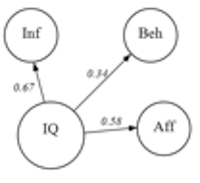
Figure 3. Correlations between intellectual abilities (RPM result) and indicators of adaptation criteria in Cluster 1.
This confirms our hypothesis that first graders with a high level of agency, whose ISP was formed before starting school (as a result of the age crisis) use their intellectual resources to solve adaptation crisis problems.
Adolescent crisis and crises of fifth graders’ and tenth graders’ adaptation to the next educational level
First, by using the k-means method of cluster analysis, we divided all the pupils into clusters with similar agency level. Cluster 1 (67%) comprised pupils with a high level of agency. Cluster 2 (33%) comprised pupils with a low level of agency (see Figure 4).The differences between the clusters were proven for every characteristic by using the U-test (p < 0,000). We did not observe any statistically significant differences in intellectual level (measured by RPM) between the clusters of pupils (U=189,5; p=0,65). After comparing the pupils' personal traits (see Figure 5), we posed the following conclusions. The fifth graders from Cluster 2 are characterised by a statistically significant higher level of factors D, E, F, O, and Q4. These signs are the signs of the adolescence crisis beginning for fifth graders from Cluster 2.
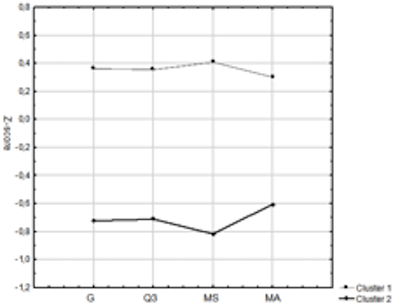
Figure 4. Agency level in clusters: G, Q3, motives of achieving (MA), and self-development (MS).

Figure 5. Personal traits in clusters of fifth graders (measured by CPQ).
To explore the peculiarities of intellectual and personal resource application to overcoming an adaptation crisis, we calculated Spearman's rank correlation coefficient between the pupils’ recourses (intellectual and personal) and the indicators of adaptation criteria in both clusters of fifth graders. We found many statistically significant correlations (p<0.05) between these parameters in Cluster 1 (see Figure 6).


Figure 6. Correlations between recourses (intellectual and personal) and adaptation criteria indicators in clusters of fifth graders.
In Cluster 2, only isolated correlations were found. We also observed the absence of statistically significant correlations between the RPM result and the indicators of adaptation criteria in Cluster 2. This finding confirms our hypothesis that fifth graders with a high level of agency, whose ISP has been preserved, because the adolescence crisis did not begin, use their intellectual resources and personal traits to successfully adapt to and overcome crises.
Similar results have been obtained with a sample of tenth graders. First, by using the k-means method of cluster analysis, we divided all the pupils into clusters with similar agency level. Cluster 1 (72%) comprised pupils with a high level of agency. Cluster 2 (28%) comprised pupils with a low level of agency (see Figure 7).
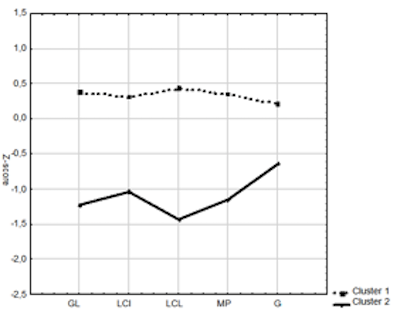
Figure 7. Agency level in clusters: Goals in Life – GL; Locus of Control – LCI, LCL; motive for profession training MP; G factor.
The differences between the clusters were proven for every characteristic by using the U-test (p < 0,001). We did not observe any statistically significant differences in the intellectual level (measured by RPM) between the clusters of pupils. By comparing the pupils' personal traits (seeFigure 8), we pose the following conclusions. The tenth graders from Cluster 1 are characterised by a statistically significant higher level of factors A, C, F, and H and a lower level of factors J, O, and Q2. These signs are the signs of the adolescence crisis resolution of tenth graders from Cluster 1.
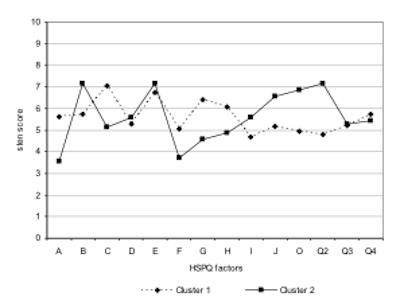
Figure 8. Personal traits in clusters of tenth graders (measured by HSPQ).
To explore the peculiarities of intellectual and personal resource application to overcoming an adaptation crisis, we calculated Spearman's rank correlation coefficient between the RPM and HSPQ results and the indicators of adaptation criteria in both clusters of tenth graders. We found some statistically significant positive correlations (p<0.05) between personal traits and adaptation criteria indicators in Cluster 1 (see Figure 9).
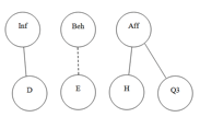
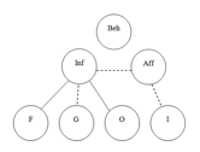
Figure 9. Correlations between recourses (intellectual and personal) and adaptation criteria indicators in clusters of tenth graders.
Social boldness (H) and self-discipline (Q3) are the main adaptation recourses for pupils with a high level of agency (Cluster 1). This finding partially confirms our hypothesis that tenth graders with a high level of agency, whose self-consciousness and I-concept has been formed as a result of adolescence crisis resolution, use their personal resources to successfully overcome the adaptation crisis.
In Cluster 2, mostly negative correlations were found. We observed positive correlations only between information criteria indicators and personal traits such as liveliness (F) and apprehension (O); however, they are not resources.
Additionally, the absence of statistically significant correlations between the information criteria indicator (academic performance) and RPM result, and self-discipline (Q3) and rule consciousness (G) was observed. This was caused by individual learning style and that school conditions did not change, in general.
Youth crisis and the crisis of freshmen’s adaptation to university learning
First, by using the k-means method of cluster analysis, we divided all the pupils into clusters with similar agency level. We could not divide the sample of freshmen into two clusters because of the variance in motivation indicators in the group of the students with a low level of agency personal traits. Thus, we used three clusters (see Figure 10).
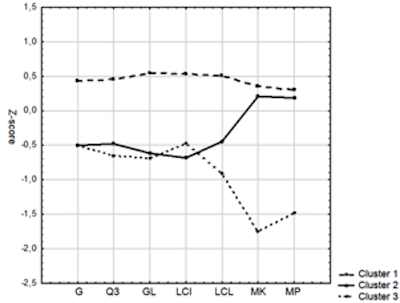
Figure 10. Agency level in clusters: Goals in Life – GL; Locus of Control – LCI, LCL; MK – motive of knowledge obtaining, MP – motive of professional training; G, Q3 factors 16PF.
Cluster 1 (54%) comprised students with a high level of these agency indicators. Cluster 2 (31%) comprised students with a low level of personal traits but a high level of motivation; these students, we assert, want to learn but have not yet determined their life goals. Cluster 3 (15%) comprised students with a low level of personal traits and low level of motivation; we posited that these students entered the university not as a result of their conscious choice.
The students' personal traits comparison (see Figure 11) led to the following conclusions. The freshmen from Cluster 1 are characterised by a statistically significant higher level of factors A, C, G, and Q3 and a lower level of factor O.
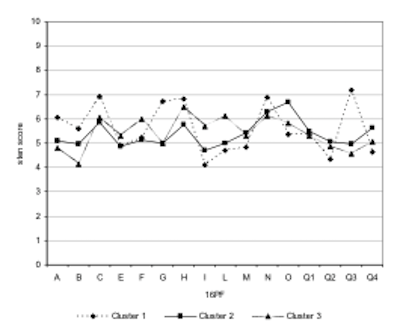
Figure 11. Personal traits in clusters of freshmen (measured by 16PF).
To explore the peculiarities of intellectual and personal resource application to overcoming adaptation crisis, we calculated Spearman's rank correlation coefficient between the students’ recourses (intellectual and personal) and the indicators of the adaptation criteria in each cluster of freshmen. We found a statistically significant positive correlation (p<0.05) between personal traits and adaptation criteria indicators in Cluster 1. In Clusters 2 and 3 only isolated links, mostly negative, were found (see Figure 12). We noticed that the Unified State Exam results (USE) connected with adaptation criteria in only Cluster 1.
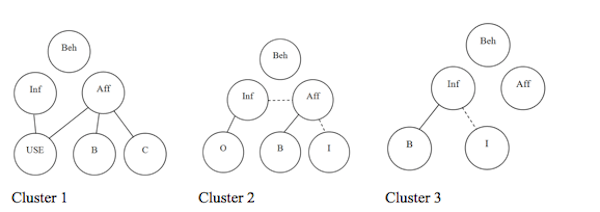
Figure 12. Correlations between personal traits and adaptation criteria indicators in clusters of freshmen.
This confirms our hypothesis that only freshmen with a high level of agency, whose readiness to master the consciously chosen profession, use their psychological resources (intellectual abilities, knowledge, personal traits) to adaptation crisis successful overcoming.
Discussion
In modern society, educational conditions in schools and universities have often been changed without considering students’ needs (Samokhvalova, Kryukova, 2016; Symanyuk, Pecherkina, 2016; Akçinar, 2013; Karabanova, 2010; Deci et al., 1991). On the one hand, this phenomenon leads to changes in the psychological context of age-related crises; on the other hand, it increases the duration of educational crises because new educational conditions and demands came without students’ “needs and aspirations.”The results of the surveys demonstrated that students’ agency is the key factor of normative educational crises successful overcome. In each age category of students, we obtained the same result: In the group of students with a high level of agency indicators (i.e., Cluster 1) we observed many positive correlation links between indicators of psychological resources and indicators of adaptation crisis overcome criteria. In the group(s) of students with a low level of agency indicators (i.e., in Cluster 2 and in samples of first graders and freshmen, Cluster 3), we observed only isolated correlation links between indicators of psychological resources and indicators of adaptation crisis overcome criteria. Consequently, educational results in Cluster 1 were determined by students’ recourses. However, the same was not true for Clusters 2-3. This explains why smart, good children do not learn well often.
Conclusion
The result of the study confirms our hypothesis: Only students with a high level of agency use their psychological resources to successfully overcome normative educational crises. Students with a low agency level do not use their resources in full during the normative educational crises: These, students despite their capacities, have a negative emotional state and problems in learning and behaviour. This finding is true for each age category of students. Thus, without human agency qualities, the intellectual and personal resources of students can remain unused during the period of adaptation and further training, as the results of the study demonstrated.
Limitations
The lack of statistically significant correlations between indicators of psychological resources and adaptation criteria may also be due to the small size of groups.
Acknowledgements
This research was funded by the Russian Foundation for Basic Research (RFBR) grant number 18-413-400001
References
Akçinar, B. (2013). The Predictors of School Adaptation in Early Childhood. Procedia - Social and Behavioral Sciences, 93, 1099-1104. https://doi.org/10.1016/j.sbspro.2013.09.338
Abulkhanova, K.A. (2005). Princip subekta v otechestvennoj psihologii [The Principle of Subject in Russian Psychology]. Psihologiya. Zhurnal Vysshej shkoly ehkonomiki[Psychology. Journal of the Higher School of Economics], 2(4), 3-21.
Asmolov, A.G. (2013). Strategy and methodology for the sociocultural reform of education. Psychology in Russia: State of the Art, 6(1), 3-20. https://doi.org/10.11621/pir.2013.0101
Barber, B.K., Olsen, J.A. (2004). Assessing the Transitions to Middle and High School. Journal of Adolescent Research, 19(1), 3-30. https://doi.org/10.1177/0743558403258113
Balconi, M. (2010). The Sense of Agency in Psychology and Neuropsychology. In Michela B. (eds) Neuropsychology of the Sense of Agency. Springer, Milano. Retrieved from https://doi.org/10.1007/978-88-470-1587-6_1
Bandura, A. (1989). Human Agency in Social Cognitive Theory. American Psychologist, 44, 1175–1184. https://doi.org/10.1037/0003-066X.44.9.1175
Belolutskaya, A., Veraksa, N. (2016). The multidimensionality of thinking in the context of creativity studies: structural-dialectical approach. European Society for Research in Adult Development. Book of Abstracts. Hague, Netherlands, p. 28.
Białecka-Pikul, M. et al. (2017). Self-understanding in Adolescence: Dimensions, Development, and Stability. Paper presented at the 18th European Conference on Developmental Psychology, Utrecht. Retrieved from http://www.ecdp2017.nl/wp-content/uploads/sites/43/2017/08/ECDP2017-Abstract-book-V2.compressed.pdf
Borchet, J. et al. (2017). The role of sibling in relation between self-esteem and parentification in adolescence. Paper presented at the 18th European Conference on Developmental Psychology, Utrecht. Retrieved from http://www.ecdp2017.nl/wp-content/uploads/sites/43/2017/08/ECDP2017-Abstract-book-V2.compressed.pdf
Bozhovich, L.I. (1968). Lichnost i eyo formirovanie v detskom vozraste [Personality and its Development in Childhood]. Moscow: Prosveshchenie.
Cattell, R.B., Eber, H.W., & Tatsuoka, M.M. (1970). Handbook for the Sixteen Personality Factor Questionnaire(16PF). Champaign, IL: IPAT.
Cowen, E.L., Dorr, D., Clarfield, S., et. al. (1973). A quick‐screening device for early identification of school maladaptation, American Journal of Community Psychology, 1 (1), 12-35. https://doi.org/10.1007/BF00881243
Deci, E.L., Vallerand, R.J., Pelletier, L.G., Ryan, R.M. (1991). Motivation and education: The self-determination perspective. The Educational Psychologist, 26, 325-346. https://doi.org/10.1207/s15326985ep2603&4_6
Hardy, C.L., Bukowski, W.M., Sippola, L.K. (2002). Stability and Change in Peer Relationships during the Transition to Middle-Level School. Journal of Early Adolescence, 22, p.117-142. https://doi.org/10.1177/0272431602022002001
Hewson, M. (2010). In A. Mills, G. Durepos, & E. Wiebe (Eds.) Encyclopedia of case study research(pp. 13-17). Thousand Oaks, CA: SAGE Publications.
Ilienkov E.V. (2009). Shkola dolzhna uchit myslit[Schools must teach how to think]. Moscow: Russian Academy of Education. (Original work published in 1964).
Karabanova, O.A. (2010). Social Situation of Child's Development - the Key Concept in Modern Developmental Psychology. Psychology in Russia: State of the Art, 3, 130-153. https://doi.org/10.11621/pir.2010.0005
Koops, W. (2017). The role of agency in adolescent research. Paper presented at the 18th European Conference on Developmental Psychology, Utrecht. Retrieved from http://www.ecdp2017.nl/wp-content/uploads/sites/43/2017/08/ECDP2017-Abstract-book-V2.compressed.pdf
Leontiev, D., Lebedeva, A., Kostenko, V. (2017). Pathways of Personality Development: Following Lev Vygotsky’s Guidelines. Educational Studies, 2, 98-112. https://doi.org/10.17323/1814-9545-2017-2-98-112
Leontiev, D.A. (2002). Purpose-in-Life Test. Moscow: Smysl
Leontiev, D.A. (2010). What the Concept of Subject Contritutes to Psychology: Agency as a Personality Dimension. Epistemology & Philosophy of science, 25(3), 135-153.
Leontiev, A.N. (2003). Stanovlenie psikhologii deyatelnosti: rannie raboty[The becoming of activity psychology: early writings] Moscow: Smysl.
Lomov, B.F. (1975). O sistemnom podhode v psihologii[System approach in psychology] Voprosy psihologii[Issues of Psychology], 2, 31-45
Luria, A.R. (2002). Priroda chelovecheskih konfliktov[Human Conflicts Nature]. Мoscow: Cogito.
Nisskaya, A.K. (2018). School readiness outcomes of different preschool educational approaches. Psychology in Russia: State of the Art, 11(1), 43-60. https://doi.org/10.11621/pir.2018.0104
Nezhnova, T.A. (1988). Dinamika vnutrennej pozicii pri perekhode ot doshkolnogo k mladshemu shkolnomu vozrastu. [Inner schoolboy position changing from preschool to primary school children]. The Moscow University Bulletin. Series 14. Psychology, 1, 50-61.
Polito, V., Waters, F.A.V., & McIlwain, D. (2015). Sense of agency: Theory, methods, and application. Psychology of Consciousness: Theory, Research, and Practice, 2(3), 207-209. https://doi.org/10.1037/cns0000073
Polivanova, K.N. (2015). The Psychology of Age-Related Crises. Journal of Russian & East European Psychology, 52 (2), 14-82. https://doi.org/10.1080/10610405.2015.1064734
Porter, R.B. & Cattell, R.B. (1985). Handbook for the Children's Personality Questionnaire(CPQ), Champaign, IL: IPAT.
Raven, J., Raven, J.C. and Court, J.H. (2000). Raven Manual: Section 3. SPM Manual (Including the Parallel and Plus Versions). 2000 Edition, Oxford: Oxford Psychologists Press.
Rukavishnikov, A.A. (2002). Faktornyj licnostnyj oprosnik R.Kettella. Metodicheskoe rukovodstvo [CPQ, HSPQ, 16PF of R.Cattell. Manual] St. Petersburg: IMATON.
Samokhvalova, A. G., Kryukova, T.L. (2016). Communication difficulties in teenagers with health impairments.Psychology in Russia: State of the Art, 9(3), 113-126. https://doi.org/10.11621/pir.2016.0308
Slobodchikov, V.I. (1991). Kategoria vozrasta v psihologii i pedagogike razvitiya [The Concept of Age in Developmental Psychology and Pedagogy]. Voprosy psihologii [Issues of Psychology], 2, 37-50.
Slobodchikov, V.I. (2008). Antropologicheskij smysl krizisov perekhoda v razvitii i obrazovanii [Anthropological sense of transition crises in development and education]. Psychology of Education, 1, 4-25.
Symanyuk, E. E., Pecherkina, A. A. (2016). Psychological predictors of inhibition development in educational environments. Psychology in Russia: State of the Art, 9(3), 127-140. https://doi.org/10.11621/pir.2016.0309
Rean, A.A., Yakunin, V.A. (2004). Techniques for diagnostics of educational motivation of pupils and students. St. Petersburg: Piter.
Vygotsky, L.S. (1983). Problemy razvitiya psihiki[Problems of the psyche development]. Мoscow: Pedagogika.
To cite this article: Leonova, E.V. (2019). Overcoming Normative Educational Crises: The Human Agency Factor. Psychology in Russia: State of the Art, 12(3), 121–136.
The journal content is licensed with CC BY-NC “Attribution-NonCommercial” Creative Commons license.









